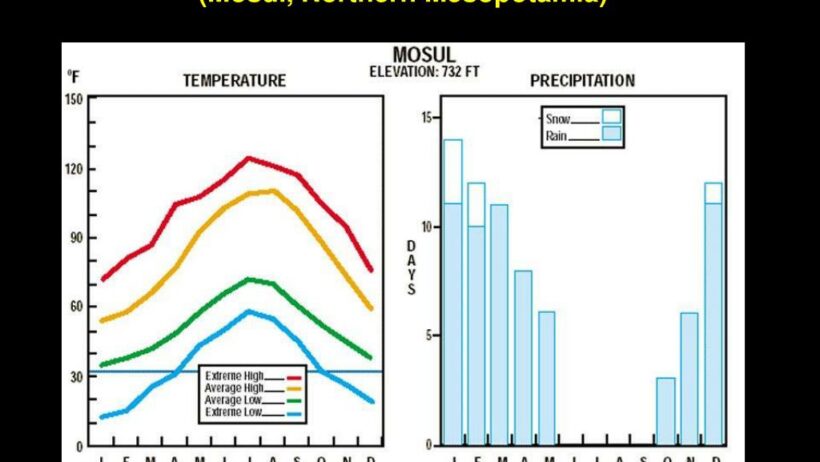The climate of Mesopotamia, often referred to as the “Cradle of Civilization,” played a pivotal role in shaping the development of ancient societies that thrived between the Tigris and Euphrates rivers. This geographic region, representing modern-day Iraq, parts of Syria, Turkey, and Iran, was characterized by diverse and sometimes extreme weather conditions that significantly influenced agriculture, settlement patterns, and the overall lifestyle of its inhabitants.
To understand the climate of ancient Mesopotamia, it is essential to recognize its geographical context. The region is surrounded by mountains to the north and desert to the west and south. This topography contributes to a varied climate, which can be generally categorized into two main types: the arid climate and a more temperate climate in the northern highlands.
1. Arid Climate of Southern Mesopotamia
The southern part of Mesopotamia, primarily known as Sumer, experienced a hot desert climate, typified by long, scorching summers and short, mild winters. Average temperatures in the summer could soar above 40 degrees Celsius (104 degrees Fahrenheit), while winter temperatures rarely dipped below 5 degrees Celsius (41 degrees Fahrenheit). Rainfall in this region was scant, averaging only 100 to 200 mm annually. This scarcity of precipitation heavily dictated agricultural practices, compelling ancient farmers to develop advanced irrigation techniques to divert water from the Tigris and Euphrates rivers to sustain crops.
2. Seasonal Variation and Agricultural Impact
Despite the arid conditions, Mesopotamia benefitted from a distinct seasonal cycle that contributed to agricultural productivity. The spring months, particularly March to May, brought an increase in rainfall, which helped to rejuvenate the soil. This phenomenon, often termed the “flood cycle,” saw the rivers swelling with water, depositing nutrient-rich silt along their banks. The importance of this seasonal inundation cannot be overstated, as it allowed for the cultivation of staple crops, including barley and wheat, which were essential for food security. The reliance on this cyclical phenomenon led to the establishment of a calendar that was integral to agricultural planning and religious festivals, serving as a cornerstone for Sumerian civilization.
3. The Role of Irrigation
Advanced irrigation systems became central to the sustainability of agriculture in the otherwise inhospitable climate. The construction of canals, dikes, and reservoirs reflects the ingenuity of Mesopotamian engineers and the centralized authority of rulers. This infrastructural ingenuity allowed farmers to harness the rivers’ resources effectively and create a surplus of crops. Such agricultural success facilitated the growth of cities and complex societies, enabling trade, governance, and cultural developments. Nevertheless, reliance on irrigation also posed challenges, including soil salinization, which eventually affected agricultural output and led to societal decline.
4. Climate of Northern Mesopotamia
In stark contrast, northern Mesopotamia, encompassing territories such as Assyria, experienced a more temperate climate, ripe for different agricultural practices. This region benefited from higher altitudes, resulting in cooler temperatures and increased rainfall, ranging from 400 to 800 mm per year. These conditions promoted the growth of diverse crops and supported pastoral activities, providing a buffer against the climatic extremes faced by their southern counterparts. The variation in climate contributed to a richer tapestry of cultural and economic practices across Mesopotamia.
5. Impact of Climate Change
6. Cultural Significance of Weather
The Mesopotamians deeply understood their environment, which was reflected in their mythology, literature, and religion. Deities represented various natural phenomena, and weather patterns influenced rituals and agricultural calendars. Festivals often coincided with seasonal changes, celebrating the fertility of the earth and the vital role of the rivers. This interconnection between climate and culture underscored the importance of weather in their daily lives and spiritual beliefs.
7. Conclusion
The climate of ancient Mesopotamia was a formidable force that shaped every aspect of life, from agriculture to urban development, and influenced the very fabric of society. As the “Cradle of Civilization,” it serves as a testament to human resilience and ingenuity in the face of climatic challenges. Understanding the climate of this pivotal region offers valuable insights into the complexities of environmental adaptation and the historical trajectory of human societies. Mesopotamia’s legacy lives on, reminding us of the inherent link between environment and civilization, an intricate relationship that continues to be relevant in discussions about climate change and sustainability today.








